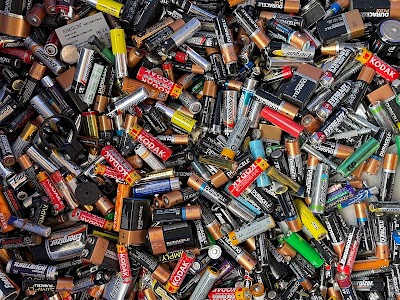Types of batteries
Primary batteries
Are the batteries that are used once and cannot be charged, and are disposed of when they are finished, and they are one of the simple and convenient sources of energy used in many electrical and portable devices; Such as watches, cameras, lights, toys, etc., and this type of battery is usually lightweight and inexpensive, and does not need maintenance. The primary batteries used for simple devices are usually cylinder-shaped, although they can be produced in different shapes and sizes.Secondary batteries
They are batteries that can be recharged and discharged several times, and that consist of reverse cellular reactions that allow them to be recharged by passing electric currents. There are 4 types of secondary batteries, which are as follows:Lead-acid battery: It is one of the most common types of batteries in photovoltaic systems, although it has low energy density and high maintenance requirements, but it has a long life and low costs compared to other types of batteries, and it is the most common form of battery in most battery applications. Rechargeable, as it is used in the operation of car engines, and therefore it has a strong technical base, and the battery consists of two electrodes, the negative electrode is made of porous spongy lead that is easy to disintegrate, and the positive electrode is made of lead oxide, as it is immersed in the electrolyte consisting of sulfuric acid And water, and when the electrodes come into contact through the physical movement of the battery, or through changes in the thickness of the electrodes, the insulating membrane separates electrically and chemically connects, as this membrane helps to create an electrical short in the electrolyte solution, and thus the battery will store energy through chemical reactions.
Lithium Battery: It consists of 4 main components, which are as follows:
- Cathode: The source of lithium ions, which determines the capacity and voltage of the battery.
- The elevator: which stores the lithium ions generated by the electric current flowing through the external circuit and coming from the cathode at start-up.
- Electrolyte solution: It consists of salts, solvents and some other additives, which facilitates the movement of electrons from the cathode to the anode.
- Separator: It is a barrier between the elevator and the landing strip.
Nickel-cadmium battery: It is the battery used in laptop computers, electric drills, and other battery-powered devices by discharging energy, and this battery uses electrodes made of nickel hydroxide, metallic cadmium, and an alkaline electrolyte solution of potassium hydroxide.
Sealed Maintenance-Free Battery This type of battery is limited in maintenance, and is used to save energy, or in low-power operating systems, and this type of battery is also used to generate power in areas that suffer from energy deficits such as rural areas.[1]







Great! your blog is very interesting and informative because this blog contains meaningful content.
ReplyDeleteIf your are looking for these ev charging point operators in india.
Our company provides the best services in India
Great! your blog is very interesting and informative because this blog contains meaningful content.
ReplyDeleteIf your are looking for these ev charging point operators in india.
Our company provides the best services in India